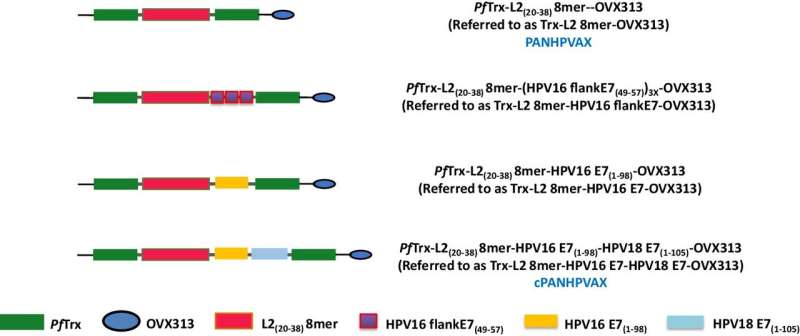This article has been reviewed according to Science X's editorial process and policies. Editors have highlighted the following attributes while ensuring the content's credibility:
fact-checked
peer-reviewed publication
trusted source
proofread
New vaccine against cervical cancer combines prophylactic and therapeutic activity

A new vaccine against cancer-causing human papillomaviruses (HPV) is intended to help increase the rate of HPV vaccinations, particularly in developing countries. Scientists at the German Cancer Research Center (DKFZ) have developed a completely new vaccination concept for this purpose.
The paper is published in the journal npj Vaccines.
The vaccine is inexpensive and protects mice against almost all cancer-causing HPV types. In addition to preventing new infections, the vaccine also triggers cellular immune responses against HPV-infected cells and may therefore also have a therapeutic effect against existing infections.
Cervical cancer caused by certain types of human papillomavirus (HPV) is the fourth most common cancer in women worldwide. The majority of cases are diagnosed in less developed countries, particularly in South East Asia, Africa and Latin America. The carcinogenic so-called risk HPVs are mainly transmitted during sexual contact. The infections are very common.
It is assumed that up to 80% of the population will come into contact with these viruses in their lifetime. In addition to cervical cancer, infections with high-risk HPV are also associated with oral cancer, anal cancer and other cancers of the genital organs.
The vaccines currently available against cancer-causing HPV are effective, but have limitations. They are temperature-sensitive and therefore require continuous refrigerated transportation, which poses a logistical problem in some countries. Their production is complex and expensive. In addition, they are only effective against certain cancer-causing HPV types. Above all, however, the established HPV vaccines show no therapeutic effects on existing infections.
In developing their new HPV vaccine, Müller and his colleagues took a systematic approach to solving all these problems. The basis for this was the "predecessor model" PANHPVAX, which was also developed in Müller's laboratory: this exclusively prophylactic vaccine has already proven to be safe in phase I clinical trials and induces protective antibodies against all cancer-causing HPV as well as against some cutaneous papillomaviruses.
For PANHPVAX, the researchers used small fragments of the L2 protein from eight different HPV types. These fragments differ only slightly between different HPV types and can therefore trigger a very broad immune response. To make these protein snippets immunogenic, they were inserted into a suitable scaffold protein derived from a heat-loving microorganism (Pyrococcus furiosus).
"In our current work, we have added a therapeutic component to PANHPVAX, i.e. an antigen that stimulates the cellular immune response," explains Müller. The DKFZ virologists chose the protein E7 of the two high-risk types HVP16 and 18. It is formed very early in the course of an HPV infection in the infected cells and is therefore an ideal target for a cellular immune response to eliminate these cells. However, E7 is also responsible for the malignant transformation of HPV-infected cells. The researchers therefore first had to modify the vaccine antigen so that it no longer posed a threat.
In preclinical studies, the new vaccine cPANHPVAX was able to trigger neutralizing antibodies against all carcinogenic HPV in mice and simultaneously activate cytotoxic T cells against the HPV16 protein E7.
These positive results encouraged the researchers to now produce cPANHPVAX under conditions that comply with Good Manufacturing Practice (GMP) guidelines for pharmaceuticals. The vaccine produced in this way can be used in clinical trials.
"Our major goal is to increase vaccination rates against HPV worldwide, especially in countries with limited resources. Our new, heat-stable vaccine is inexpensive to produce, protects against all cancer-causing HPV types and can potentially neutralize existing infections by combining it with E7," the researcher says.
In order to further investigate the promising properties of cPANHPVAX, the researchers are currently developing a concept for clinical testing of the vaccine.
More information: Xueer Zhao et al, A safe and potentiated multi-type HPV L2-E7 nanoparticle vaccine with combined prophylactic and therapeutic activity, npj Vaccines (2024). DOI: 10.1038/s41541-024-00914-z




















